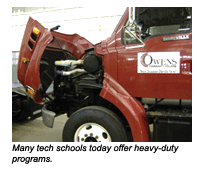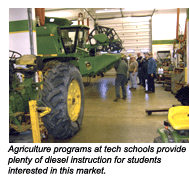
It’s certainly no secret that the engine rebuilding industry has been hurt by better quality, longer-lasting automobile engines. The same thing but taken to an even greater extreme – can be said about the heavy-duty diesel engine market.
The quality of today’s engines – both automotive and diesel – is so much better than it was 10 years ago, explains David Bianchi, B&G Machine, Seattle, WA. Today, an on-highway truck engine is basically guaranteed to run a million miles. I’ve seen an engine that went 2.4 million miles before they even put bearings into it. As a heavy-duty and high horsepower diesel facility, we’ve had to meet the challenge and it has meant a lot of changes in our shop.
According to Engine Builder’s 2004 Machine Shop Market Profile, the percentage of its readers who say they offer various kinds of diesel service is as follows:
Automotive Diesel: 54.7%
Medium-Duty Diesel: 46.2%
Heavy-Duty Diesel: 34.9%
Industrial: 56.6%
What these numbers don’t tell is how much work is done in each category. The Engine Rebuilders Association’s (AERA) Dave Hagen explains that the challenge of identifying a particular market is somewhat difficult because different people look at the same thing in different ways.
There’s no real clear split to recognize which engine is medium and which is heavy duty, Hagen says. It’s kind of like trying to determine and describe the difference between medium and medium-well of a fine tenderloin two people will look at the same steak differently. And no matter how you cut that steak it will be delicious. But as diesel rebuilders revealed, taking a bite of the heavy-duty diesel market is unlikely to be quite as satisfying if you’re not prepared to keep chewing.
Generally, heavy-duty implies an engine found in on-highway and lighter-duty off-highway vehicles, explains Bianchi. This includes engines around 600 hp, such as those you would find in a semi. But our business also goes to pieces of equipment, such as mining haul trucks, bulldozers – the engines go up to 2,000 or more horsepower.
Don Dickerhoff, with Diesel Power and Machine in Pierceton, IN, explains that his shop specializes in building Caterpillar, Cummings, John Deere and Case IH engines for businesses all over the country. We work in the 150-700 hp range. Occasionally we’ll build a 7.6L John Deere as an industrial motor but that’s about as small as we’ll go, Dickerhoff explains. According to Bryan Menke, of R&R Machine in Akron, OH, the on- and off-highway markets have continued to keep his shop busy, and changes in the emissions rules means he has had to make significant investments.
The main impact from the new emissions regulations has been in the equipment we have had to buy, Menke explains. The steps to rebuilding a motor have pretty much stayed the same, but the computer systems, the diagnostic equipment, the handheld systems – those have been necessary.
According to Mike Conlon, legal council for AERA and the Automotive Parts Rebuilders Association (APRA), in the mid 1990s, government rulings required automotive manufacturers to make OBD information available to the aftermarket. However, the heavy-duty aftermarket didn’t benefit by these rulings so shops have been on their own to locate and use repair information and tools.
Recent legislation indicates rules requiring access to tools and information may be passed eventually, but won’t apply to engines and vehicles prior to 2010 model year.
So, rebuilders are forced to accept the challenge of servicing the heavy-duty diesel market or look for other forms of business. Neither option is a particularly simple choice.
The OE has done a great job of marketing its service, acknowledges Bianchi of the typical on-highway truck customer. The average customer’s first stop is his local OEM supplier and normally it doesn’t go beyond that.
The potential size of the market is a challenge, says Dickerhoff, simply because there are so many fewer heavy-duty diesels produced, There are probably a thousand times fewer heavy-duty diesels produced than small, light duty diesels. When you’re used to working on those little engines in such mass quantities, you simply can’t treat these big engines the same. Plus, with the type of horsepower they produce and the dollars they cost, rebuilders must be very careful.
 Warranty issues are one of Dickerhoff’s ongoing business battles, and he cautions prospective rebuilders to anticipate them. We’ve watched companies try to compete with us for years, and they always seem to get back out again. The warranties will kill you.
Warranty issues are one of Dickerhoff’s ongoing business battles, and he cautions prospective rebuilders to anticipate them. We’ve watched companies try to compete with us for years, and they always seem to get back out again. The warranties will kill you.
Dickerhoff warns the only way to learn to survive is to have a few warranty comebacks. It’s taken us 25 years of warranties to get us to our current level, he says. And they’ll continue to plague us. Even if all we sold were brand new engines,. it would be an issue typically because of misapplication, mis-installation and maintenance issues.
Dickerhoff says parts proliferation plague Diesel Power and Machine. We typically keep 300 complete engines in inventory. To be able to do that to have the engine a guy needs on the shelf when he needs it – means you have to have a very close handle on your parts.
Menke says he works with a number of trucking fleets, and has seen significantly more competition for rebuilding business from the OEMs themselves. The vehicle manufacturers are getting much more competitive, on both parts and complete engines. They want the business and they’re selling more parts to the older trucks and second generation owners as well. Their prices have come down significantly thanks to demands from the aftermarket.
Heavy-Duty Opportunities
Because there has been such an interest from the OEMs to recapture much of the on-highway engine market, shops are rightfully looking at alternative businesses. Heavy-duty diesel service may be among those options.
There’s a bit of a stigma attached to diesel engine work, admits B&G’s Bianchi. You have to know your specs and the tolerances are critical. But becoming more flexible in our shop operations has given us the opportunity to go into markets we formerly wouldn’t have addressed.
Bianchi says that, just as in the automotive sector, identifying niche markets is a great way for diesel engine rebuilders to improve – or start a business.
We’ve been focusing our attention on the markets I see as having real opportunity, and, for us, those include industrial diesel engines. This allows us to go into, for example, a gold mine in Nevada, and explain that we can offer every engine they might need for their equipment, he says.
Aggressive sales and marketing outside the traditional channels mean we’re hitting the mining, marine, stationary power generation and oil and gas industrial markets pretty hard. Those have good margins for us.
With a family history in the trucking business, Dickerhoff sees a great deal of opportunity advertising to small fleets and trucking companies capitalizing on durable vehicles available with equipment options.
Some guys will decide to get into the trucking business and buy a used truck an auction, Dickerhoff says. It may cost them $25,000, and the first thing they think about doing is to spend another $25,000 on an OEM rebuilt engine. A lot of times they tell me they see our ad that they can get the same motor from us for $16,000.
Dickerhoff says the price of combines, 4WD tractors, semis, farm and industrial equipment has gotten so expensive that users don’t have the luxury of waiting for their heavy-duty diesel motor to be rebuilt. We don’t deal with a guy needing an engine to get back and forth to work. If his car breaks down, he can usually get a ride with someone if he needs to. But when you’re dealing with farmers, livestock dealers and truck fleets, it’s not just a convenience factor. Their livelihoods are on the line and we have to be able to produce what they need when they need it.
To do this sometimes in only three days Dickerhoff says his company stocks an amazing number of parts. Even if we don’t have the complete engine on the shelf, we always have the components to produce it … in any variation needed, he says. This means we stock every fuel pump, every injector for every different classification and combination for every model of engine. Most people can’t comprehend that … but it’s what we need to do.
While the challenges facing newcomers to the heavy-duty diesel rebuilding market may be daunting, Bianchi explains that the industry as a whole can help with its support. I’m a big advocate of supporting the growth and health of our industry. We should compare notes, taking and sharing ideas on what we are and can be doing. Whatever opportunities are out there, we should collectively take advantage of them. He says success often comes by creative thinking and encourages rebuilders to consider what they CAN do, not what they have done. There are little niches in this industry. You’ve got to look for them. You could do the common stuff all day long and make $100 an engine or you could do the same basic amount of work with some smaller heavy duty diesels and make about $3,000 an engine.
As Menke says, success is about looking for and filling the needs. We don’t turn down automotive work, but there is much more money to be made in diesels. We’ve always taken the role of filling the industry’s voids.


